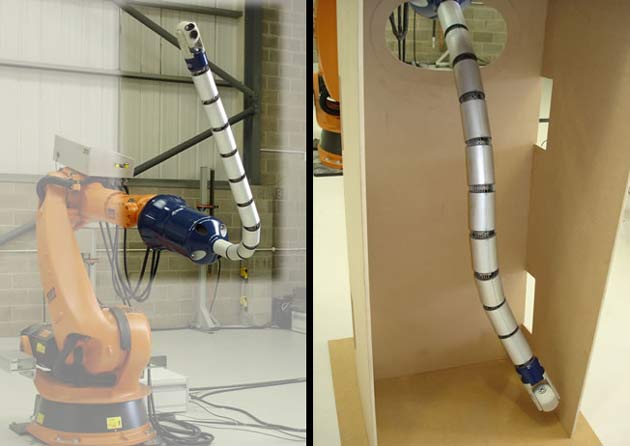Snake-Like Robot Handles Tight Spots

Snake-arm robots are going places they had never been before, thanks to OCRobotics and KUKA Roboter. The OCRobotics snake-arm robot has just reached the first major milestone for assembly and inspection tasks within aircraft wings.
OCRobotics has completed build and initial testing of a demonstration snake-arm robot capable of sealing, swaging and inspection inside a mock-up of a rib bay. The aerospace industry has been slow to use robotics on assembly lines; tasks within rib bays and other confined spaces inside aircraft structures have remained practically impossible, until now. Snake-arm robots do not have prominent "elbows." They have a continuous curving shape—like a snake. This means that they are ideal for applications in confined spaces and can reach lots of awkward places. (See Snake-Arm Robots From OCRobotics Reach Out for more details.)
In a new configuration, the OCRobotics snake-arm robot is attached to the KUKA industrial robot, which uses the snake-arm robot as a tool. It is a flexible extension to the industrial robot. Initial tests show the arm is flexible enough to deliver the required tools to areas of the wing box that were previously inaccessible to automation (see photos here).
This extraordinary ability to reach into tight spaces and seek out and manipulate objects reminded me immediately of the steel tentacles imagined by H.G. Wells in his classic 1898 novel "The War of the Worlds." We all remember the scene in which the novel's narrator is trapped in a small house:
I looked up and saw the lower surface of a handling-machine coming slowly across the hole. One of its gripping limbs curled amid the debris; another limb appeared, feeling its way over the fallen beams. I stood petrified, staring. Then I saw through a sort of glass plate near the edge of the body the face, as we may call it, and the large dark eyes of a Martian, peering, and then a long metallic snake of tentacle came feeling slowly through the hole. I turned by an effort, stumbled over the curate, and stopped at the scullery door. The tentacle was now some way, two yards or more, in the room, and twisting and turning, with queer sudden movements, this way and that. For a while I stood fascinated by that slow, fitful advance. (Read more about H.G. Wells' steel tentacles)
Fortunately, OCRobotics has found a much more practical task for "steel tentacles" to perform. They have created a real-life robot with dexterity better than anything H.G. Wells' could have imagined.
If you are interested in snake-like robots, be sure to check out the Snakebot Roundup!, which features five different robots. Read past stories about the snake-arm robot, or take a look at its friend the Octarm tentacle robot: check out the OCRobotics website.
(This Science Fiction in the News story used with permission from Technovelgy.com - where science meets fiction.)
Get the world’s most fascinating discoveries delivered straight to your inbox.


